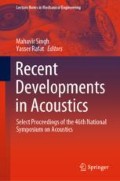Abstract
The Propeller is a vital component which is delicate for the safe operation of a ship at sea. The propeller noise is very much significant to warship designers and military strategists for many years. By using large eddy simulation (LES) it is possible to simulate the sound radiation of turbulent flows effectively, providing access to resolve turbulent scales at higher accuracy. The main aim of this paper is to study and identify a propeller which is producing less noise. The present paper deals with the prediction of the unsteady non-cavitating marine propeller noise of 5, 6, and 7 blades with +10° pitch, +5° pitch, existing pitch, and −5° pitch, −10° pitch at rotational speed 840 rpm and vehicle speeds of 7.62 m/s, using eddy viscosity model of large eddy simulation (LES) available in computational fluid dynamics fluent software and using Ffowcs Williams–Hawkings (FW-H) formulation. Here solver is chosen as pressure-based, unsteady formulation of second-order implicit. Finite volume method is used to predict the noise in time-domain acoustic analogy. Sound pressure levels are predicted at different receiver positions. The receiver position is 1 m distance in radial direction to the propeller. From this numerical study on these propellers, it is found that the propeller of 6 blades with +5° pitch generates least noise. Finalized the propeller which is producing low noise as well as which generates required Thrust and Torque by changing the diameter of the propeller. Finally, obtain the noise reduction of 9.4 dB with the new redesigned propeller when compared with the baseline propeller for the same thrust and torque.
Access this chapter
Tax calculation will be finalised at checkout
Purchases are for personal use only
References
Lighthill MJ (1952) On sound generated aerodynamically: I. General theory. Proc. Royal Society (London) A 211:564–587
Ffowcs Williams JE, Hawkings DL (1969) Sound generated by turbulence and surfaces in arbitrary motion. Philos Trans Royal Soc Series 115:1321–1342
Chang B (1998) Application of CFD to P4119 Propeller. In: 22nd ITTC Propeller RANS/Panel method workshop, France
Yang Q, Wang Y, Zhang M (2011) Calculation of propeller’s load noise using LES and BEM numerical acoustics coupling methods. Transactions of the Wessex Institute, Paper. https://doi.org/10.2495/BE110081
Bertetta D, Brizzolara S, Canepa E, Gaggero S, Viviani M (2012) EFD and CFD characterization of a CLT propeller. Int J Rotat Mach 12. Article ID 348939, 22 pages. https://doi.org/10.1155/2012/348939
Zhi-feng Z, Shi-liang F (2012) Numerical investigation of cavitation performance of ship propellers. J Hydrodyn Ser B 24(3):347–353
Song Y, Wen J, Dianlong Y, Liu Y, Wen X (2014) Reduction of vibration and noise radiation of an underwater vehicle due to propeller forces using periodically layered isolators. J Sound Vib 333:3031–3043
Yu-cun P, Huai-xin Z (2012) Numerical hydro-acoustic prediction of marine propeller noise 15(6):707–712
Muscari R, Di Mascio Andrea, Verzicco Roberto (2013) Modeling of vortex dynamics in the wake of a marine propeller. Comput Fluids 73:65–79
Yu-cun P, Huai-xin Z (2013) Numerical prediction of marine propeller noise in non-uniform inflow. China Ocean Eng 27(1):33–42
Acknowledgements
The authors wish to express their sincere gratitude to Dr. O.R. Nandagopan, Scientist ‘G’ and Director, NSTL Visakhapatnam for permitting to publish this paper. The authors also wish to acknowledge to Sri PVS Ganesh Kumar, Scientist’G’, Sri. Ch. Sankara Rao, Scientist’G’, NSTL, Visakhapatnam and Dr. S. Rama Krishna, Assoc. Prof., GVP College of Engineering, Visakhapatnam.
Author information
Authors and Affiliations
Corresponding author
Editor information
Editors and Affiliations
Rights and permissions
Copyright information
© 2021 Springer Nature Singapore Pte Ltd.
About this paper
Cite this paper
Ramakrishna, V., Bangaru Babu, P., Suryanarayana, C. (2021). Non-Cavitating Noise Control of a Marine Propeller by Optimizing Number and Pitch of Blades. In: Singh, M., Rafat, Y. (eds) Recent Developments in Acoustics. Lecture Notes in Mechanical Engineering. Springer, Singapore. https://doi.org/10.1007/978-981-15-5776-7_19
Download citation
DOI: https://doi.org/10.1007/978-981-15-5776-7_19
Published:
Publisher Name: Springer, Singapore
Print ISBN: 978-981-15-5775-0
Online ISBN: 978-981-15-5776-7
eBook Packages: EngineeringEngineering (R0)

